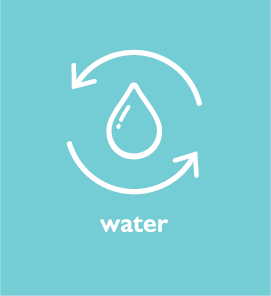Facilities Management
Environmental sustainability at Stellenbosch University

Our aim:
South Africa is listed as the 33rd driest country in the world, and it falls under the driest 20 percent out of 195 countries. Water is thus a scarce resource. In response to this, Stellenbosch University has launched a number of initiatives to conserve potable and irrigation water by reducing, reusing, and exploring alternative sources.
Projects & programmes

Greywater
Greywater from the showers in the residences on both the Stellenbosch and Tygerberg campuses is captured, treated in a central plant, and then reused to flush the toilets. We currently produce 1.2 million litres a month, which saves us from using municipal potable supply. Watch the video for more information.

Mariendal borehole and filtration system
The humans and animals at the University’s training and research farm, Mariendahl, account for 140kl/day of water consumption between them. In a bid to operate off the municipal grid and to reduce costs on the farm, the supply of potable water from the municipality through the Elsenburg network has been stopped, and all water on Mariendahl is supplied from a borehole intervention.

Filtration Plants
Filtration plants have been installed at both the Tygerberg and Bellville Park campuses. The entire campus at Bellville Park is off the municipal supply, using water from the quarry, which is filtered to SANS 241 drinking standards.
At Tygerberg, water from five boreholes is also filtered to SANS 241 drinking standards, supplying 50 % of the total water demand on campus.

Efficiency measures
- Water-efficient equipment, such as water-saving shower heads, tap aerators, and toilet cistern displacement devices, are currently being installed on our campuses.
- Water consumption is measured per building via smart meters and reported accurately on the utility dashboard.
- Water-permeable paving and grass squares are used, where possible, so that rain water can penetrate the soil and replenish the underground aquifers.
- Landscape areas are designed to retain water, which enables the absorption and storage of water.
- Water-hardy plant species, including local endemic species that require less water, are systematically planted.
- Rain water is collected and used at specific areas on campus.
- Water leakages are reported and fixed by the water warrior team.
- Irrigation with potable water has been significantly reduced.
What can you do to help:
- Report leaky taps, sprinklers, and other devices on campus to (021) 808-4666.
- Make use of reusable bottles. Three to five litres of water are used to produce one litre of bottled water.
- Be on the lookout for the new water stations with their special branding on the campuses.
In the bathroom
- Take a shower rather than a bath. A half-full bath uses 113 litres of water, while a five-minute shower uses less than 56 litres.
- Use eco-friendly soap so that the water can be re-used.
- The water from showers is recycled for greywater. Don’t contaminate it with other materials.
- Close the tap while you soap your hands, brush your teeth, or shave. A running tap wastes up to six litres of water within two minutes.
- Make sure all taps are closed properly. A dripping tap wastes up to 30 litres a day, which amounts to 10 000 litres a year.
In the Kitchen
- Rinse vegetables and fruit in a basin filled with water rather than under a running tap. Use this water in the garden afterwards.
- Avoid doing small loads of laundry in the washing machine.. Wait until you have a large load or join forces with a friend to do a load.
- Do not fill up the kettle every time you boil water.
When you Study/ work
- Communicate via electronic media. It takes 10 litres of water to produce one A4 page of paper.
Contact the Service Desk (021 808 4666) for further information or send an e-mail to groen_green@sun.ac.za.
